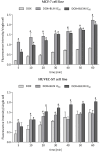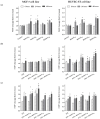Baicalin and Baicalein Enhance Cytotoxicity, Proapoptotic Activity, and Genotoxicity of Doxorubicin and Docetaxel in MCF-7 Breast Cancer Cells
- PMID: 38893380
- PMCID: PMC11173533
- DOI: 10.3390/molecules29112503
Baicalin and Baicalein Enhance Cytotoxicity, Proapoptotic Activity, and Genotoxicity of Doxorubicin and Docetaxel in MCF-7 Breast Cancer Cells
Abstract
Breast cancer is a major health concern and the leading cause of death among women worldwide. Standard treatment often involves surgery, radiotherapy, and chemotherapy, but these come with side effects and limitations. Researchers are exploring natural compounds like baicalin and baicalein, derived from the Scutellaria baicalensis plant, as potential complementary therapies. This study investigated the effects of baicalin and baicalein on the cytotoxic, proapoptotic, and genotoxic activity of doxorubicin and docetaxel, commonly used chemotherapeutic drugs for breast cancer. The analysis included breast cancer cells (MCF-7) and human endothelial cells (HUVEC-ST), to assess potential effects on healthy tissues. We have found that baicalin and baicalein demonstrated cytotoxicity towards both cell lines, with more potent effects observed in baicalein. Both flavonoids, baicalin (167 µmol/L) and baicalein (95 µmol/L), synergistically enhanced the cytotoxic, proapoptotic, and genotoxic activity of doxorubicin and docetaxel in breast cancer cells. In comparison, their effects on endothelial cells were mixed and depended on concentration and time. The results suggest that baicalin and baicalein might be promising complementary agents to improve the efficacy of doxorubicin and docetaxel anticancer activity. However, further research is needed to validate their safety and efficacy in clinical trials.
Keywords: DNA damage; apoptosis; baicalein; baicalin; cytotoxicity; docetaxel; doxorubicin.
Conflict of interest statement
The authors declare no conflicts of interest.
Figures















Similar articles
-
Selective fraction of Scutellaria baicalensis and its chemopreventive effects on MCF-7 human breast cancer cells.Phytomedicine. 2010 Jan;17(1):63-8. doi: 10.1016/j.phymed.2009.07.003. Phytomedicine. 2010. PMID: 19836937 Free PMC article.
-
Latest research progress on anticancer effect of baicalin and its aglycone baicalein.Arch Pharm Res. 2022 Aug;45(8):535-557. doi: 10.1007/s12272-022-01397-z. Epub 2022 Jul 31. Arch Pharm Res. 2022. PMID: 35908250 Review.
-
Baicalin and baicalein in modulating tumor microenvironment for cancer treatment: A comprehensive review with future perspectives.Pharmacol Res. 2024 Jan;199:107032. doi: 10.1016/j.phrs.2023.107032. Epub 2023 Dec 5. Pharmacol Res. 2024. PMID: 38061594 Review.
-
Baicalein induces apoptosis and autophagy of breast cancer cells via inhibiting PI3K/AKT pathway in vivo and vitro.Drug Des Devel Ther. 2018 Nov 16;12:3961-3972. doi: 10.2147/DDDT.S181939. eCollection 2018. Drug Des Devel Ther. 2018. PMID: 30510404 Free PMC article.
-
Baicalein and baicalin promote antitumor immunity by suppressing PD-L1 expression in hepatocellular carcinoma cells.Int Immunopharmacol. 2019 Oct;75:105824. doi: 10.1016/j.intimp.2019.105824. Epub 2019 Aug 19. Int Immunopharmacol. 2019. PMID: 31437792
Cited by
-
The effect of flavonoids on the doxorubicin efficacy in cancer treatment.Naunyn Schmiedebergs Arch Pharmacol. 2025 Jun 2. doi: 10.1007/s00210-025-04312-7. Online ahead of print. Naunyn Schmiedebergs Arch Pharmacol. 2025. PMID: 40455233 Review.
-
The Therapeutic Potential of Baicalin and Baicalein in Breast Cancer: A Systematic Review of Mechanisms and Efficacy.Curr Issues Mol Biol. 2025 Mar 11;47(3):181. doi: 10.3390/cimb47030181. Curr Issues Mol Biol. 2025. PMID: 40136435 Free PMC article. Review.
References
-
- Back N., Cohen I.R., Lajtha A., Lambris J.D., Paoletti R., Yu D., Hung M.-C. Breast Cancer Chemosensitivity. Scholars Portal; New York, NY, USA: 2007.
MeSH terms
Substances
LinkOut - more resources
Full Text Sources
Medical

